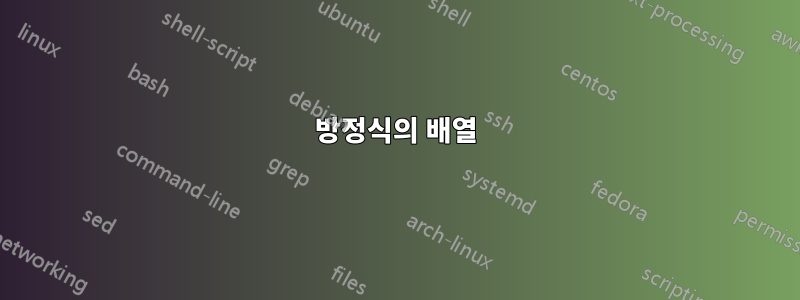
\documentclass[12pt, a4paper]{article}
\usepackage[top=0.8 in,bottom=0.8 in,left=0.7 in,right=0.6 in]{geometry}
\usepackage[utf8]{inputenc}
\usepackage[misc]{ifsym}
\usepackage{amsmath}
\usepackage{amsfonts}
\usepackage{amssymb}
\usepackage{autoaligne}
\begin{document}
\autoaligne{
(1)~ 5x+3y+7z = 4\\
3x+26y+2z= 9\\
7x+2y+10z= 5}
\hfill
\autoaligne{
(2)~x+2y-z = 3\\
x-y+z=-1\\
2x-2y+3z= 2\\
3x-y+2z= 1
}
\hfill
\autoaligne{
(3)~2x-2y+z = 1\\
x+2y+2z= 2\\
2x+y-2z=-2\\
2x-3y-z= 5
}
\end{document}
답변1
첫 번째 방정식 시스템에 네 번째 줄을 추가하면 모든 그룹의 높이가 동일하고 올바르게 정렬됩니다.
\documentclass[12pt, a4paper]{article}
\usepackage[top=0.8 in,bottom=0.8 in,left=0.7 in,right=0.6 in]{geometry}
\usepackage[utf8]{inputenc}
\usepackage[misc]{ifsym}
\usepackage{amsmath}
\usepackage{amsfonts}
\usepackage{amssymb}
\usepackage{autoaligne}
\begin{document}
\autoaligne{%
(1)~5x+3y+7z = 4\\
3x+26y+2z= 9\\
7x+2y+10z= 5\\ %<---- This was missing
}
\hfill
\autoaligne{
(2)~x+2y-z = 3\\
x-y+z=-1\\
2x-2y+3z= 2\\
3x-y+2z= 1
}
\hfill
\autoaligne{
(3)~2x-2y+z = 1\\
x+2y+2z= 2\\
2x+y-2z=-2\\
2x-3y-z= 5
}
\end{document}
답변2
다음의 수직 정렬 기능을 사용하십시오 autoaligne.
\documentclass{article}
\usepackage{autoaligne}
\begin{document}
%% vertical positioning can be c (centre), h (haut), b (bas)
\noindent
(1)~\autoaligne(h){
5x+3y+7z = 4\\
3x+26y+2z= 9\\
7x+2y+10z= 5
}\hfill
(2)~\autoaligne(h){
x+2y-z = 3\\
x-y+z=-1\\
2x-2y+3z= 2\\
3x-y+2z= 1
}\hfill
(3)~\autoaligne(h){
2x-2y+z = 1\\
x+2y+2z= 2\\
2x+y-2z=-2\\
2x-3y-z= 5
}
\end{document}





